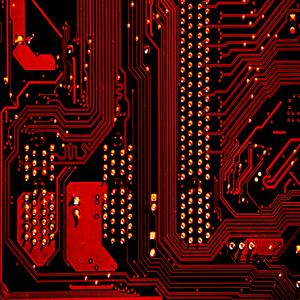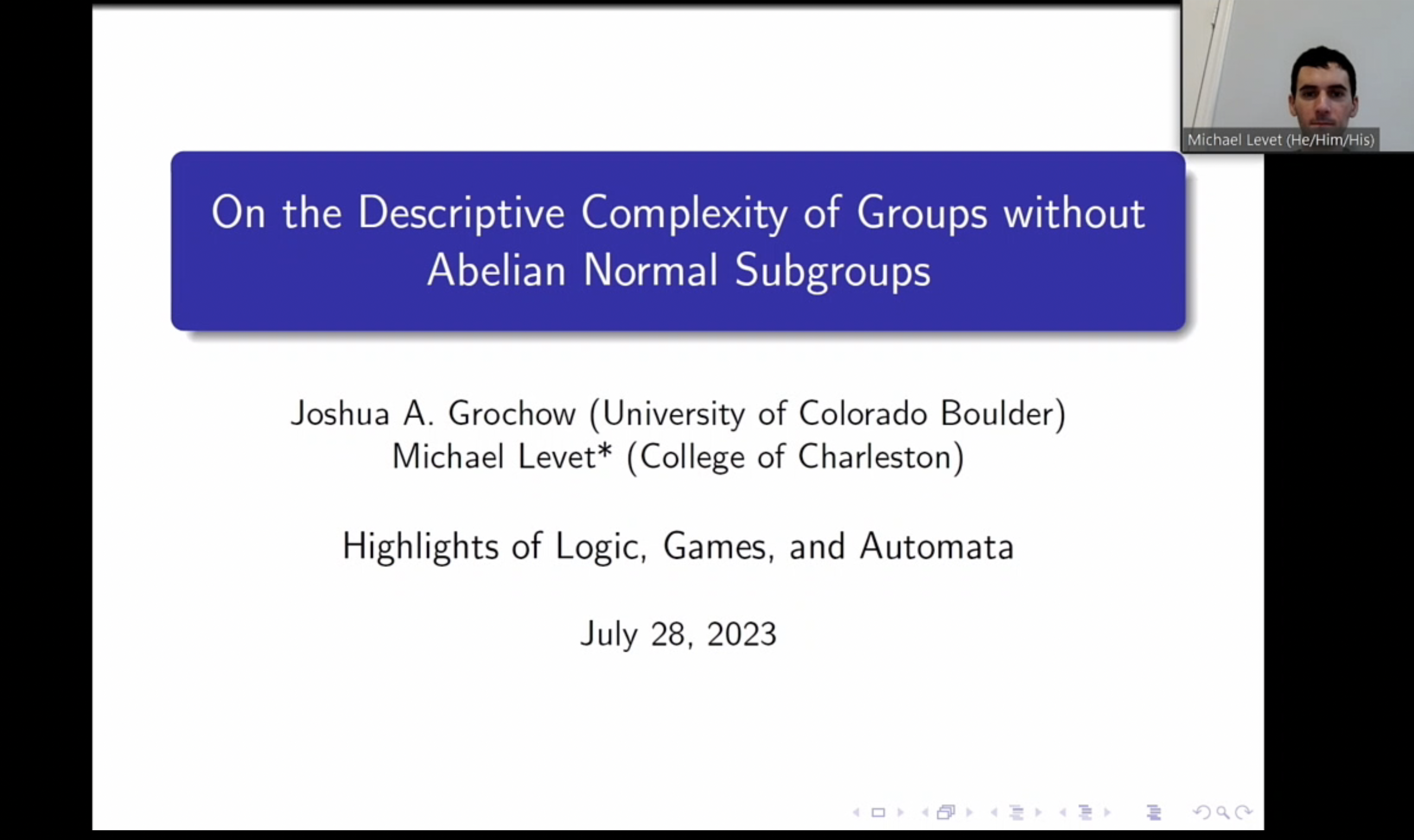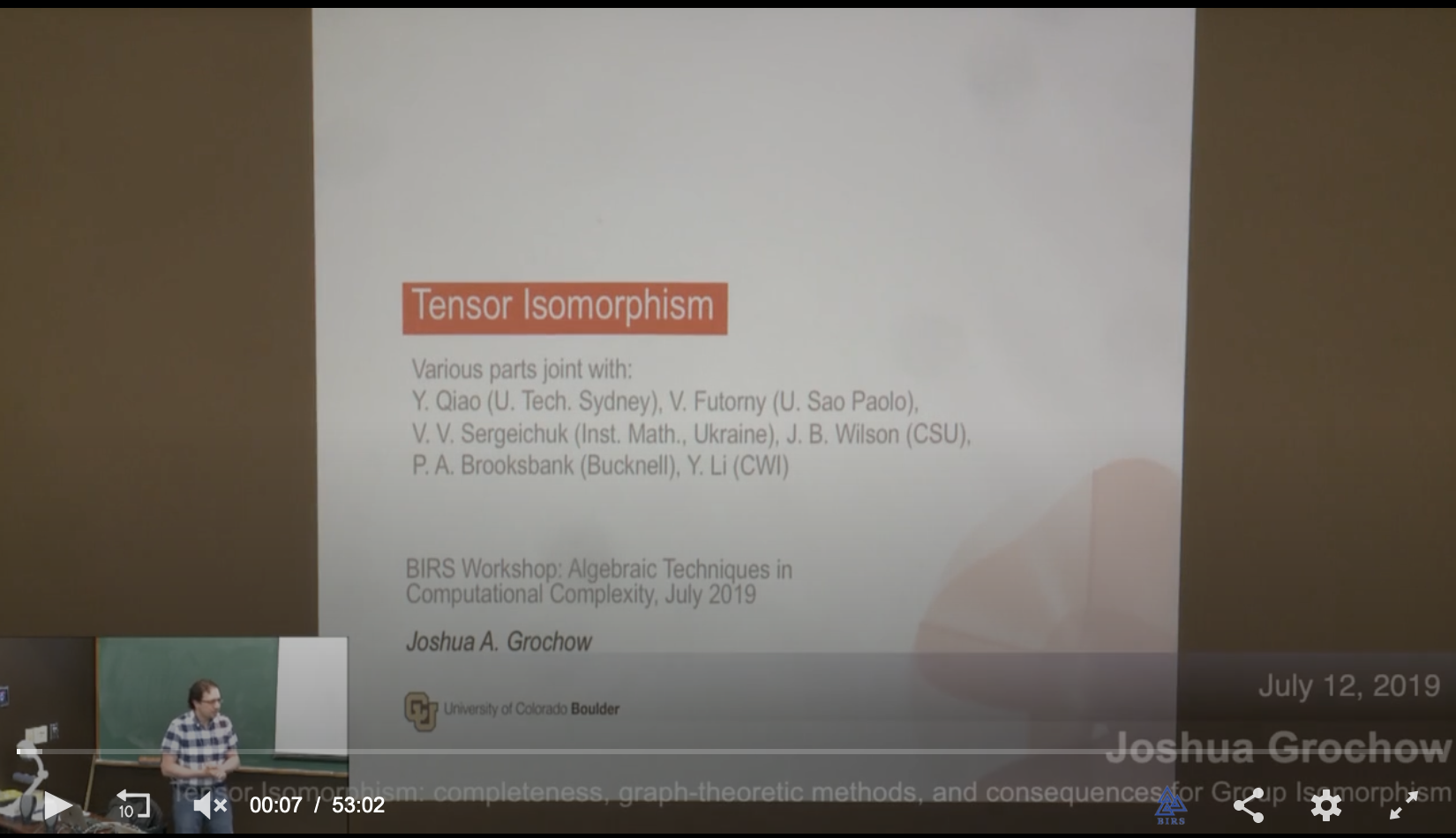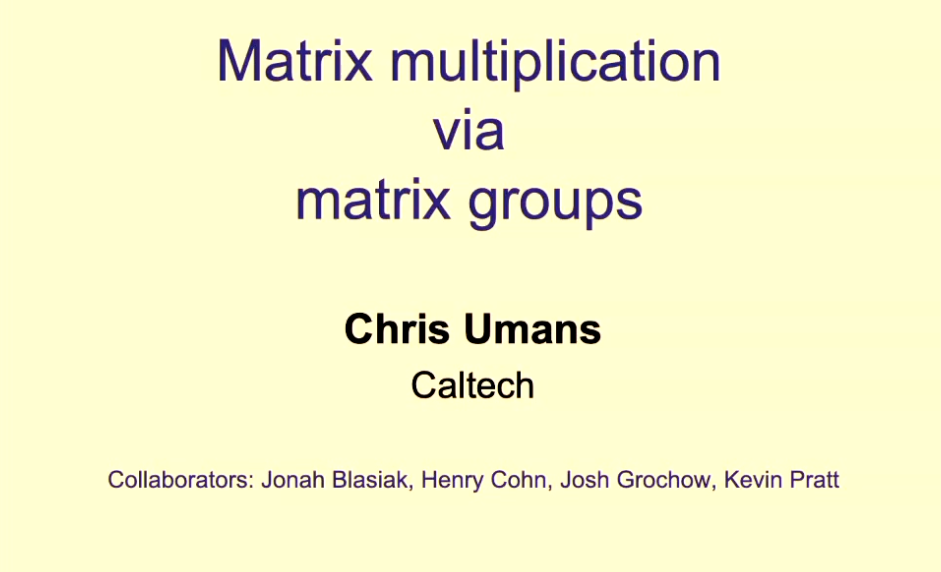Videos (newest first instead) (by topic)
Videos listed by topic, and newest first within each topic. The same video may appear under multiple topics. While I try to make almost all of my talks expository to some extent (for whatever audience they were given to at the time), the "Expository" category is for talks where the main purpose of the talk was exposition of mine or others' works, rather than presenting new research (though sometimes expository talks include a little new research as well).
Expository 
Working with Toni in Algebraic Proof Complexity
ToniCS: Celebrating the Contributions and Influence of Toniann Pitassi, Mar 2023
Based in part on Circuit complexity, proof complexity, and polynomial identity
testing: The ideal proof system joint with
and On the algebraic proof complexity of Tensor Isomorphism, CCC '23, joint with
Mentions Polynomial Identity Testing and the Ideal Proof System.
Algebraic proof complexity: a gentle
introduction
(expository)
FOCS '21 (in '22) Workshop: Reflections
on
Propositional Proofs in Algorithms & Complexity, Feb 2022
Slides
 Abstract
Abstract
Part I: Motivation, history, and introduction to algebraic proof complexity (Toniann Pitassi)
This first talk will give a quick primer on proof complexity, especially as it relates to algebraic proof systems. It will cover some of the history and motivation that led to the study of algebraic proof systems, as well as introduce some well-studied algebraic proof systems and the relations between them.
Part II: Circuit complexity, ideals and proof systems: connections and recent results (Joshua A. Grochow)
The second talk will cover connections between the Ideal Proof System (IPS), circuit complexity, and more generally complexity in ideals. In particular, it will cover the relation between IPS and VP vs VNP, as well as the recent result of Andrews & Forbes that extends the constant-depth algebraic circuit lower bound of Limaye-Srinivasan-Tavenas to a lower bound on refuting certain polynomial equations in IPS. The talk will highlight the connection between algebraic circuit complexity, algebraic proof complexity, and even Boolean circuit complexity to the complexity not of individual (families of) polynomials, but of arbitrary (families of) polynomials inside an ideal or coset of an ideal.
Codes and Expansions in Algorithms for Matrix Multiplication
(expository)
Codes and Expansions Seminar (CodEx), Feb 2021
Based partly on our paper Designing Strassen's algorithm,
Joint with .
Slides
 Abstract
Abstract
We overview some relationships between codes (and various code-like objects) and constructing algorithms for multiplying matrices, ranging from concrete results to intriguing observations of things that look similar if you squint just right.
This includes a connection between codes and bilinear complexity from Lempel & Winograd '77, symmetric algorithms for matrix multiplication (studied by many authors), and a construction of Strassen's 1969 matrix multiplication algorithm from a unitary 2-design (G. & Moore, arXiv:1708.09398). And more connections we won't have time for, but promise at least one slide about.
Tensors & Complexity I (expository)
Tensors: Algebra-Computation-Applications (TACA),
Jun 2019
Expository talk, parts of which mention key results from the following papers:
, Wildness for tensors
,
On the Complexity of Isomorphism Problems for Tensors,
Groups, and Polynomials I: Tensor Isomorphism-Completeness
 Abstract
Abstract
The first lecture will be about what computational complexity can tell us about tensors. We will review notions of reductions between problems, how we can use these notions of reduction to learn about computational difficulty. We will then cover what is known about the complexity of a variety of problems on tensors, including a first look at some very recent results (only going up on the arXiv this week!).
Tensors & Complexity II (expository)
Tensors: Algebra-Computation-Applications (TACA),
Jun 2019
 Abstract
Abstract
This second lecture will be about what tensors can tell us about computational complexity. We will see several ways - both direct and indirect - in which problems on tensors lie at the heart of lower bounds in complexity theory.

Introduction to
Computation Theory
Complexity Explorer tutorial, timeless
Algorithms and Complex Systems
Part of my Complexity Explorer tutorial, March 2019: Introduction to
Computation Theory
An introduction to Geometric Complexity
Theory (expository)
ICERM Workshop: Mathematical Aspects of P
versus NP and its Variants, Aug 2011.
Tensors & isomorphism problems 

On the descriptive
complexity of groups without Abelian normal
subgroups
Highlights of Logic, Games, and Automata, Jul 2023
Based on our joint paper On the descriptive
complexity of groups without Abelian normal
subgroups.
 Abstract
Abstract
In this talk, I will discuss the descriptive complexity theory of finite groups by examining the power of the second Ehrenfeucht—Fraïssé bijective pebble game in Hella's (Ann. Pure Appl. Log., 1989) hierarchy. This is a Spoiler-Duplicator game in which Spoiler can place up to two pebbles each round. While it trivially solves graph isomorphism, it may be nontrivial for finite groups, and other ternary relational structures. Our main result is that, in the pebble game characterization, only O(1) pebbles and O(1) rounds suffice to identify all groups without Abelian normal subgroups (a class of groups for which isomorphism testing is known to be in P; Babai, Codenotti, & Qiao, ICALP 2012). By Hella's results (ibid.), this is equivalent to saying that these groups are identified by formulas in first-order logic with generalized 2-ary quantifiers, using only O(1) variables and O(1) quantifier depth. This is joint work with Joshua A. Grochow.
Equivalences between different kinds of objects represented by hyper-matrices
HyperMatrix Workshop, Apr 2023
 Abstract
Abstract
Hyper-matrices can be used to represent many kinds of mathematical objects, from hypergraphs and tensors, to polynomials, to groups and algebras. Over the past several years, with a variety of coauthors, we have shown that nonetheless nearly all these different settings are equivalent to one another under simple (affine) linear maps, computable in polynomial time. For example, there is a map that transforms any space of matrices into a related associative algebra in such a way that two spaces of matrices are equivalent up to change of bases if and only if the corresponding algebras are isomorphic (in the usual sense of isomorphisms of algebras). As another example, we show there is a similar map from k-tensors (equivalently, k-partite pure quantum states) to 3-tensors (tripartite states), that is, 3-tensors are sufficiently rich to simulate anything that can happen even with k-tensors. In this talk, we will discuss some of these results, the techniques that go into them, and some of their implications. Based on joint works with Futorny & Sergeichuk (Lin. Alg. Appl. 2019), and Y. Qiao (ITCS '21, J. Groups, Complexity, Cryptology, 2022 also with G. Tang, CCC '21, and upcoming preprints).
On p-Group Isomorphism: search-to-decision, counting-to-decision,
and nilpotency class reductions via tensors
Conference on Computational Complexity (CCC 2021), Jul 2021
Based on our paper On p-Group Isomorphism:
search-to-decision, counting-to-decision, and nilpotency class reductions via tensors,
Joint with
On the complexity of isomorphism problems for tensors, groups, and
polynomials I: Tensor Isomorphism-completeness
12th Innovations in Theoretical Computer Science (ITCS), Jan 2021
Based on our paper On the complexity of isomorphism
problems for tensors, groups, and polynomials I: Tensor Isomorphism-completeness,
Joint with

Tensor
Isomorphism: completeness, graph-theoretic methods, and consequences for Group Isomorphism
Banff BIRS 2019 Workshop on Algebraic
Techniques in Computational Complexity, 12 Jul 2019
Based on the papers:
, Wildness for tensors
, Incorporating Weisfeiler-Leman into algorithms for group
isomorphism
,
On the Complexity of Isomorphism Problems for Tensors,
Groups, and Polynomials I: Tensor Isomorphism-Completeness
,
On p-Group Isomorphism: search-to-decision,
counting-to-decision, and nilpotency class reductions via tensors
 Abstract
Abstract
We consider the problems of testing isomorphism of tensors, p-groups, cubic forms, algebras, and more, which arise from a variety of areas, including machine learning, group theory, and cryptography. Despite a perhaps seeming similarity with Graph Isomorphism, the current-best algorithms for these problems (when given by bases) are still exponential - for most of them, even qn2 over GF(q). Similarly, while efficient practical software exists for Graph Isomorphism, for these problems even the best current software can only handle very small instances (e.g., 10 x 10 x 10 over GF(13)). This raises the question of finding new algorithmic techniques for these problems, and/or of proving hardness results.
We show that all of these problems are equivalent under polynomial-time reductions, giving rise to a class of problems we call Tensor Isomorphism-complete (TI-complete). We further show that testing isomorphism of d-tensors for any fixed d (at least 3) is equivalent to testing isomorphism of 3-tensors. Using the same techniques, we show two first-of-their-kind results for Group Isomorphism (GpI): (a) a reduction from isomorphism of p-groups of exponent p and class c < p, to isomorphism of p-groups of exponent p and class 2, and (b) a search-to-decision reduction for the latter class of groups in time |G|O(log log|G|). We note that while p-groups of class 2 have long been believed to be the hardest cases of GpI, as far as we are aware this is the first reduction from any larger class to this class of groups. Finally, we discuss a way to apply combinatorial methods from Graph Isomorphism (namely, Weisfeiler-Leman) to Group and Tensor Isomorphism.
Based on joint works with Vyacheslav V. Futorny and Vladimir V. Sergeichuk (Lin. Alg. Appl., 2019; arXiv:1810.09219), with Peter A. Brooksbank, Yinan Li, Youming Qiao, and James B. Wilson (arXiv:1905.02518), and with Youming Qiao (arXiv:1907.00309).
Tensors & Complexity I (expository)
Tensors: Algebra-Computation-Applications (TACA),
Jun 2019
Expository talk, parts of which mention key results from the following papers:
, Wildness for tensors
,
On the Complexity of Isomorphism Problems for Tensors,
Groups, and Polynomials I: Tensor Isomorphism-Completeness
 Abstract
Abstract
The first lecture will be about what computational complexity can tell us about tensors. We will review notions of reductions between problems, how we can use these notions of reduction to learn about computational difficulty. We will then cover what is known about the complexity of a variety of problems on tensors, including a first look at some very recent results (only going up on the arXiv this week!).
Tensors & Complexity II (expository)
Tensors: Algebra-Computation-Applications (TACA),
Jun 2019
 Abstract
Abstract
This second lecture will be about what tensors can tell us about computational complexity. We will see several ways - both direct and indirect - in which problems on tensors lie at the heart of lower bounds in complexity theory.
Graph automorphism & circuit size
Simons Institute Workshop: Connections
Between Algorithm Design and Complexity Theory, Oct 2015
Based on , Graph Isomorphism and circuit size.
Eventually became , Minimum Circuit Size, Graph Isomorphism, and Related Problems.
Matrix multiplication 

Matrix multiplication via matrix groups
7th Workshop on Algebraic Complexity Theory (WACT), Mar 2023
Based on our paper Matrix multiplication via matrix
groups,
Joint with
 Abstract
Abstract
Cohn and Umans proposed a group-theoretic approach to bounding the exponent of matrix multiplication. Previous work within this approach ruled out certain families of groups as a route to obtaining omega = 2, while other families of groups remain potentially viable. In this work we turn our attention to matrix groups, whose usefulness within this framework was relatively unexplored. We first show that finite groups of Lie type cannot prove omega = 2 within the group-theoretic approach. This is based on a representation-theoretic argument that identifies the second-smallest dimension of an irreducible representation of a group as a key parameter that determines its viability in this framework. Our proof builds on Gowers' result concerning product-free sets in quasirandom groups. We then give another barrier that rules out certain natural matrix group constructions that make use of subgroups that are far from being self-normalizing. Our barrier results leave open several natural paths to obtain exponent 2 via matrix groups. To explore these routes we propose working in the continuous setting of Lie groups, in which we develop an analogous theory. Obtaining the analogue of exponent 2 in this potentially easier setting is a key challenge that represents an intermediate goal short of actually proving omega = 2. We give constructions in the continuous setting, which evade our two barriers, and indeed are "best-possible" in a precise sense. We then describe a new ingredient -- "separating polynomials" -- which allow us to recover a full-fledged framework yielding actual algorithms in the Lie setting (rather than constructions whose interest is only by analogy).
Matrix multiplication via matrix groups
14th Innovations in Theoretical Computer Science (ITCS), Jan 2023
Based on our paper Matrix multiplication via matrix
groups,
Joint with
Codes and Expansions in Algorithms for Matrix Multiplication
(expository)
Codes and Expansions Seminar (CodEx), Feb 2021
Based partly on our paper Designing Strassen's algorithm,
Joint with .
Slides
 Abstract
Abstract
We overview some relationships between codes (and various code-like objects) and constructing algorithms for multiplying matrices, ranging from concrete results to intriguing observations of things that look similar if you squint just right.
This includes a connection between codes and bilinear complexity from Lempel & Winograd '77, symmetric algorithms for matrix multiplication (studied by many authors), and a construction of Strassen's 1969 matrix multiplication algorithm from a unitary 2-design (G. & Moore, arXiv:1708.09398). And more connections we won't have time for, but promise at least one slide about.
Designing Strassen's algorithm for matrix
multiplication
LA Combinatorics & Complexity
Seminar, Nov 2020
Based on our paper Designing Strassen's algorithm,
Joint with .
Geometric Complexity Theory 
An introduction to Geometric Complexity
Theory (expository)
ICERM Workshop: Mathematical Aspects of P
versus NP and its Variants, Aug 2011.
Proof complexity & polynomial identity testing (PIT)
Working with Toni in Algebraic Proof Complexity
ToniCS: Celebrating the Contributions and Influence of Toniann Pitassi, Mar 2023
Based in part on Circuit complexity, proof complexity, and polynomial identity
testing: The ideal proof system joint with
and On the algebraic proof complexity of Tensor Isomorphism, CCC '23, joint with
Mentions Polynomial Identity Testing and the Ideal Proof System.
Algebraic proof complexity: a gentle
introduction
(expository)
FOCS '21 (in '22) Workshop: Reflections
on
Propositional Proofs in Algorithms & Complexity, Feb 2022
Slides
 Abstract
Abstract
Part I: Motivation, history, and introduction to algebraic proof complexity (Toniann Pitassi)
This first talk will give a quick primer on proof complexity, especially as it relates to algebraic proof systems. It will cover some of the history and motivation that led to the study of algebraic proof systems, as well as introduce some well-studied algebraic proof systems and the relations between them.
Part II: Circuit complexity, ideals and proof systems: connections and recent results (Joshua A. Grochow)
The second talk will cover connections between the Ideal Proof System (IPS), circuit complexity, and more generally complexity in ideals. In particular, it will cover the relation between IPS and VP vs VNP, as well as the recent result of Andrews & Forbes that extends the constant-depth algebraic circuit lower bound of Limaye-Srinivasan-Tavenas to a lower bound on refuting certain polynomial equations in IPS. The talk will highlight the connection between algebraic circuit complexity, algebraic proof complexity, and even Boolean circuit complexity to the complexity not of individual (families of) polynomials, but of arbitrary (families of) polynomials inside an ideal or coset of an ideal.
Tensors & Complexity II (expository)
Tensors: Algebra-Computation-Applications (TACA),
Jun 2019
 Abstract
Abstract
This second lecture will be about what tensors can tell us about computational complexity. We will see several ways - both direct and indirect - in which problems on tensors lie at the heart of lower bounds in complexity theory.
Other complex systems 
Algorithms and Complex Systems
Part of my Complexity Explorer tutorial, March 2019: Introduction to
Computation Theory
Total
information flow in stochastic networks
Santa Fe Institute REU final presentation, 2015
Eventually turned into Comparing Information-Theoretic Measures
of Complexity in Boltzmann Machines,
Joint with myself and .
5-minute Lightning Research Talk
Santa Fe Institute Board Meeting, 2015
Other computational complexity 
Polynomial-time Axioms of Choice and polynomial-time
cardinality
U. Connecticut Logic Colloquium, Jan 2023
Based on the paper Polynomial-Time Axioms of Choice and
Polynomial-Time Cardinality,
 Abstract
Abstract
Many versions of the Axiom of Choice (AC), though equivalent in ZF set theory, are inequivalent from the computational point of view. When we consider polynomial-time analogues of AC, many of these different versions can be shown to be equivalent to other more standard questions about the relationship between complexity classes. We will use some of these formulations of AC to motivate several complexity questions that might otherwise seem a bit bespoke and unrelated from one another.
Next, as many versions of AC are about cardinals, in the second half of the talk we introduce a polynomial-time version of cardinality, in the spirit of polynomial-time model theory. As this is a new theory, we will discuss some of the foundational properties of polynomial-time cardinality, some of which may be surprising when contrasted with their set-theoretic counterparts. The talk will contain many open questions, and the paper contains even more! Based on arXiv:2301.07123 [cs.CC].

Introduction to
Computation Theory
Complexity Explorer tutorial, timeless
Algorithms and Complex Systems
Part of my Complexity Explorer tutorial, March 2019: Introduction to
Computation Theory
Sorting and
the information-theoretic lower bound: a structural analysis
Santa Fe Institute REU final presentation, 2015
Extended into her undergraduate thesis The Structure of Partial
Orders in the Face of Lower Bounds
Graph automorphism & circuit size
Simons Institute Workshop: Connections
Between Algorithm Design and Complexity Theory, Oct 2015
Based on , Graph Isomorphism and circuit size.
Eventually became , Minimum Circuit Size, Graph Isomorphism, and Related Problems.
